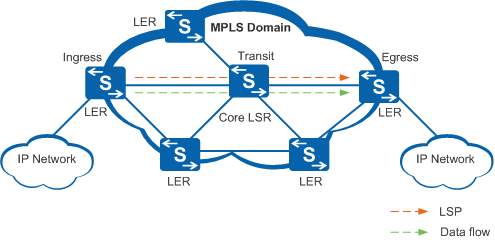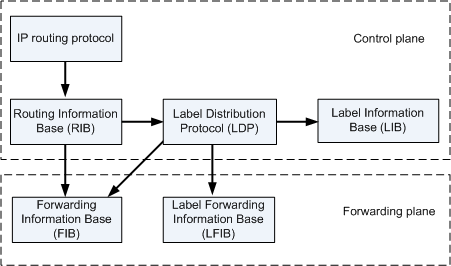Basic MPLS Architecture
MPLS Network Structure
Figure 1 shows a typical MPLS network structure. Packets are forwarded on an MPLS network based on labels. In Figure 1, network devices that swap MPLS labels and forward packets are label switching routers (LSRs), which form an MPLS domain. LSRs that reside at the edge of the MPLS domain and connect to other networks are called label edge routers (LERs), and LSRs within the MPLS domain are core LSRs.
When IP packets reach an MPLS network, the ingress LER analyzes the packets and then adds appropriate labels to them. All LSRs on the MPLS network forward packets based on labels. When IP packets leave the MPLS network, the egress LER pops the labels.
A path along which IP packets are transmitted on an MPLS network is called a label switched path (LSP). An LSP is a unidirectional path in the same direction data packets traverse.
As shown in Figure 1, the LER at the starting point of an LSP is the ingress node, and the LER at the end of the LSP is the egress node. The LSRs between the ingress node and egress node along the LSP are transit nodes. An LSP may have zero, one, or several transit nodes and only one ingress node and one egress node.
On an LSP, MPLS packets are sent from the ingress to the egress. In this transmission direction, the ingress node is the upstream node of the transit nodes, and the transit nodes are the downstream nodes of the ingress node. Similarly, transit nodes are the upstream nodes of the egress node, and the egress node is the downstream node of the transit nodes.
MPLS Architecture
Figure 2 shows the MPLS architecture, which consists of a control plane and a forwarding plane.
The MPLS architecture has the following parts:
Control plane: generates and maintains routing and label information
Routing information base (RIB): is generated by IP routing protocols and used to select routes.
Label distribution protocol (LDP): allocates labels, creates a label information base (LIB), and establishes and tears down LSPs.
Label information base (LIB): is generated by LDP and used to manage labels.
Forwarding plane (data plane): forwards IP packets and MPLS packets
Forwarding information base (FIB): is generated based on routing information obtained from the RIB and used to forward common IP packets.
Label forwarding information base (LFIB): is created by LDP on an LSR and used to forward MPLS packets.

